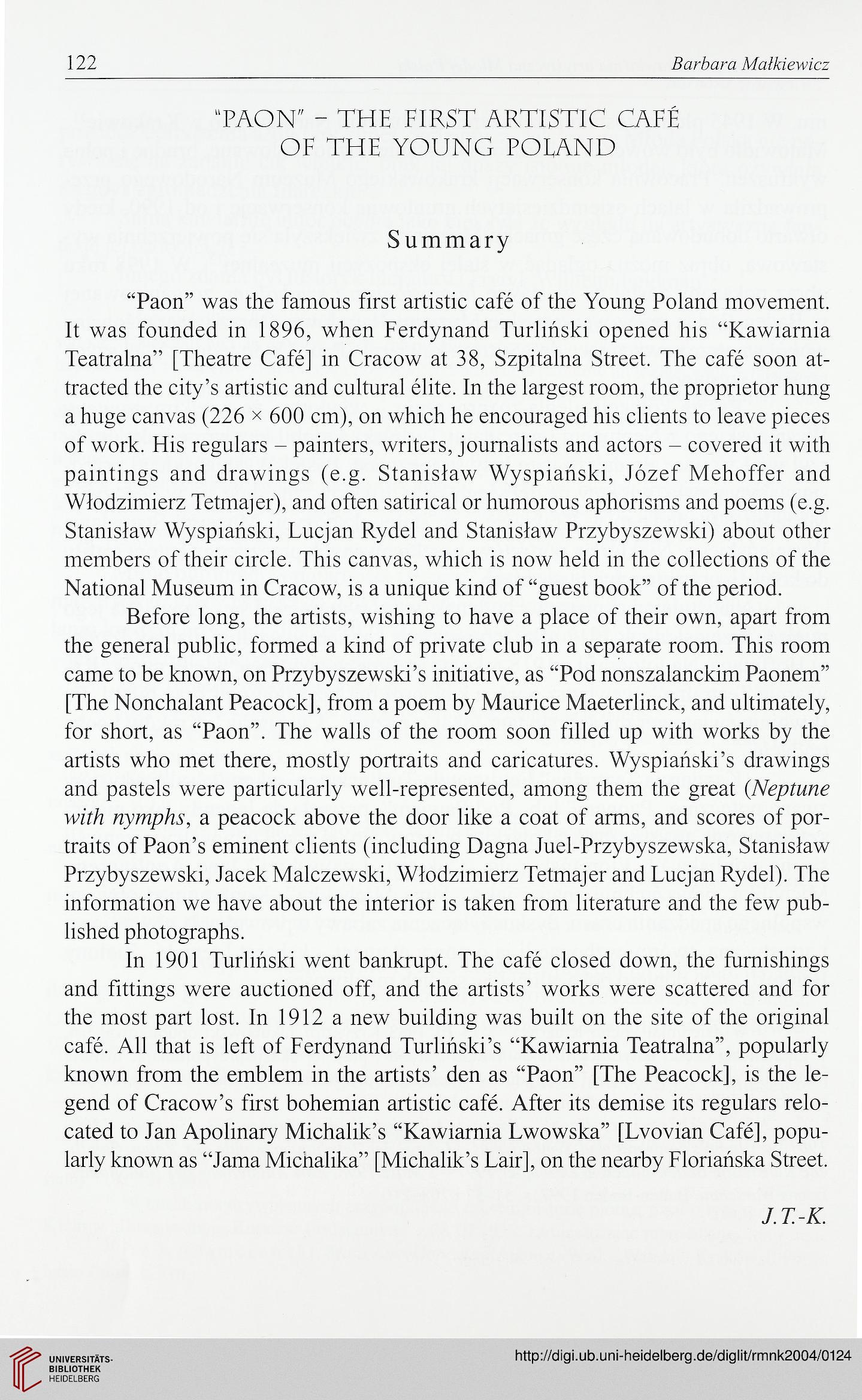122
Barbara Małkiewicz
"PAON" - THE FIRST ARTISTIC CAFE
OF THE YOUNG POEAND
S ummary
“Paon” was the famous First artistic cafe of the Young Poland movement.
It was founded in 1896, when Ferdynand Turliński opened his “Kawiarnia
Teatralna” [Theatre Cafe] in Cracow at 38, Szpitalna Street. The cafe soon at-
tracted the city’s artistic and cultural elite. In the largest room, the proprietor hung
a huge canvas (226 x 600 cm), on which he encouraged his clients to leave pieces
of work. His regulars - painters, writers, joumalists and actors - covered it with
paintings and drawings (e.g. Stanisław Wyspiański, Józef Mehoffer and
Włodzimierz Tetmajer), and often satirical or humorous aphorisms and poems (e.g.
Stanisław Wyspiański, Lucjan Rydel and Stanisław Przybyszewski) about other
members of their circle. This canvas, which is now held in the collections of the
National Museum in Cracow, is a uniąue kind of “guest book” of the period.
Before long, the artists, wishing to have a place of their own, apart from
the generał public, formed a kind of private club in a separate room. This room
came to be known, on Przybyszewski^ initiative, as “Pod nonszalanckim Paonem”
[The Nonchalant Peacock], from a poem by Maurice Maeterlinck, and ultimately,
for short, as “Paon”. The walls of the room soon filled up with works by the
artists who met there, mostly portraits and caricatures. Wyspiański’s drawings
and pastels were particularly well-represented, among them the great (Neptune
with nymphs, a peacock above the door like a coat of arms, and scores of por-
traits of Paon’s eminent clients (including Dagna Juel-Przybyszewska, Stanisław
Przybyszewski, Jacek Malczewski, Włodzimierz Tetmajer and Lucjan Rydel). The
information we have about the interior is taken from literaturę and the few pub-
lished photographs.
In 1901 Turliński went bankrupt. The cafe closed down, the fumishings
and fittings were auctioned off, and the artists’ works were scattered and for
the most part lost. In 1912 a new building was built on the site of the original
cafe. Ali that is left of Ferdynand TurlińskFs “Kawiarnia Teatralna”, popularly
known from the emblem in the artists’ den as “Paon” [The Peacock], is the le-
gend of Cracow’s first bohemian artistic cafe. After its demise its regulars relo-
cated to Jan Apolinary Michalik’s “Kawiarnia Lwowska” [Lvovian Cafe], popu-
larly known as “Jama Michalika” [Michalik’s Lair], on the nearby Floriańska Street.
J.T.-K.
Barbara Małkiewicz
"PAON" - THE FIRST ARTISTIC CAFE
OF THE YOUNG POEAND
S ummary
“Paon” was the famous First artistic cafe of the Young Poland movement.
It was founded in 1896, when Ferdynand Turliński opened his “Kawiarnia
Teatralna” [Theatre Cafe] in Cracow at 38, Szpitalna Street. The cafe soon at-
tracted the city’s artistic and cultural elite. In the largest room, the proprietor hung
a huge canvas (226 x 600 cm), on which he encouraged his clients to leave pieces
of work. His regulars - painters, writers, joumalists and actors - covered it with
paintings and drawings (e.g. Stanisław Wyspiański, Józef Mehoffer and
Włodzimierz Tetmajer), and often satirical or humorous aphorisms and poems (e.g.
Stanisław Wyspiański, Lucjan Rydel and Stanisław Przybyszewski) about other
members of their circle. This canvas, which is now held in the collections of the
National Museum in Cracow, is a uniąue kind of “guest book” of the period.
Before long, the artists, wishing to have a place of their own, apart from
the generał public, formed a kind of private club in a separate room. This room
came to be known, on Przybyszewski^ initiative, as “Pod nonszalanckim Paonem”
[The Nonchalant Peacock], from a poem by Maurice Maeterlinck, and ultimately,
for short, as “Paon”. The walls of the room soon filled up with works by the
artists who met there, mostly portraits and caricatures. Wyspiański’s drawings
and pastels were particularly well-represented, among them the great (Neptune
with nymphs, a peacock above the door like a coat of arms, and scores of por-
traits of Paon’s eminent clients (including Dagna Juel-Przybyszewska, Stanisław
Przybyszewski, Jacek Malczewski, Włodzimierz Tetmajer and Lucjan Rydel). The
information we have about the interior is taken from literaturę and the few pub-
lished photographs.
In 1901 Turliński went bankrupt. The cafe closed down, the fumishings
and fittings were auctioned off, and the artists’ works were scattered and for
the most part lost. In 1912 a new building was built on the site of the original
cafe. Ali that is left of Ferdynand TurlińskFs “Kawiarnia Teatralna”, popularly
known from the emblem in the artists’ den as “Paon” [The Peacock], is the le-
gend of Cracow’s first bohemian artistic cafe. After its demise its regulars relo-
cated to Jan Apolinary Michalik’s “Kawiarnia Lwowska” [Lvovian Cafe], popu-
larly known as “Jama Michalika” [Michalik’s Lair], on the nearby Floriańska Street.
J.T.-K.




